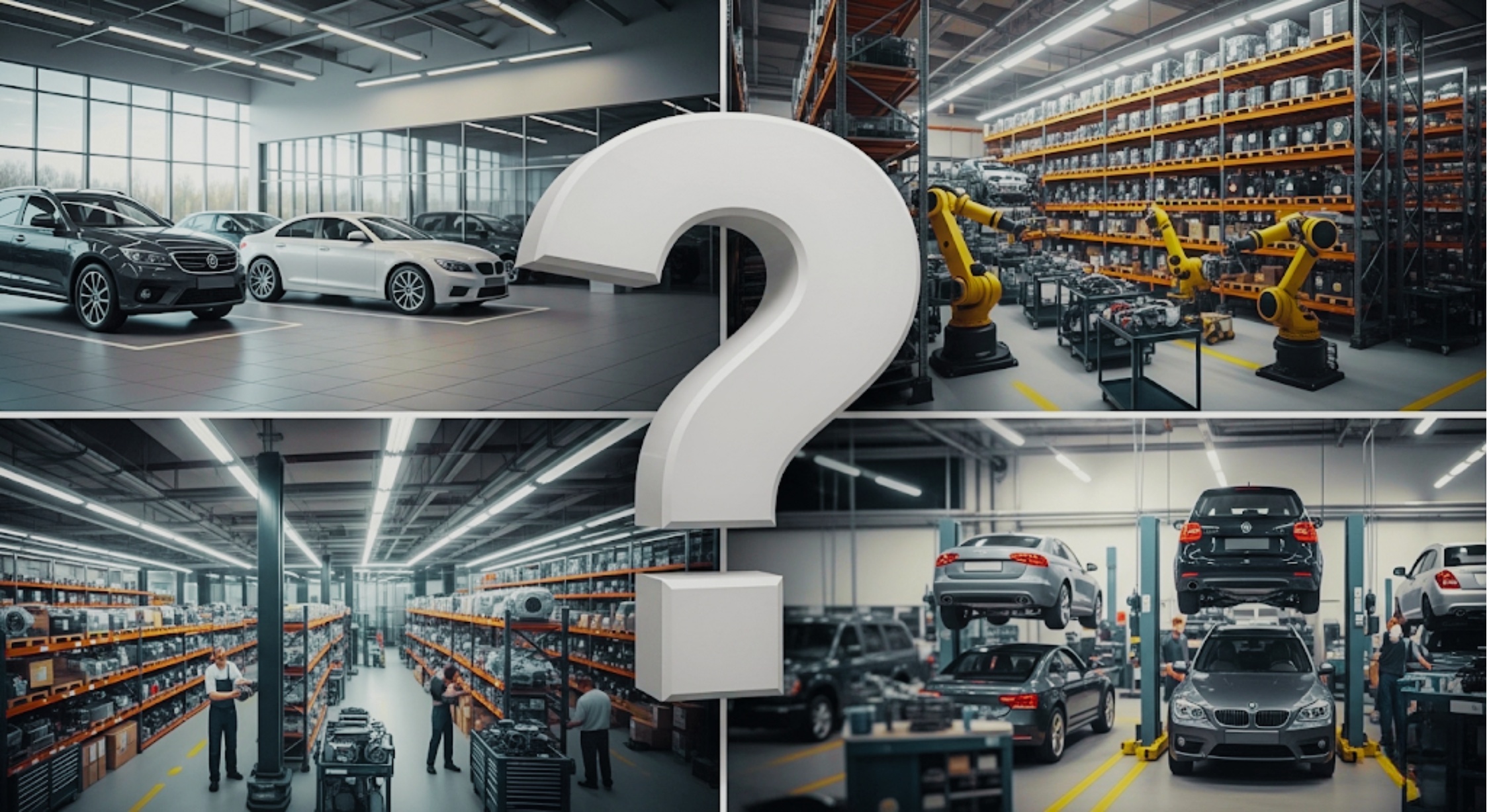Optimize Your Inventory. Drive Efficiency. Empower Your Business.
At Experion, we help automotive businesses stay ahead by building intelligent, scalable automotive inventory management solutions that deliver real-time control and visibility across the supply chain.
Tackling Inventory Challenges in the Automotive Industry
Managing inventory in the automotive sector is a high-stakes balancing act. You’re not just juggling car models, you’re dealing with an intricate ecosystem of parts, accessories, SKUs, and service components that vary by make, model, year, and even region. From engine blocks to spark plugs, and windshields to wiring harnesses, each item has its own lifecycle, demand curve, and storage requirements.
The complexity deepens with fluctuating customer expectations, service timelines, and tight operating margins. A single stockout can delay a vehicle repair, trigger customer frustration, and hurt brand credibility. On the other hand, overstocking ties up capital and consumes valuable floor or warehouse space, both of which erode profitability.
And yet, many automotive businesses still rely on siloed systems or manual spreadsheets that can’t keep up with modern inventory dynamics. These outdated methods increase the risk of human error, lead to inaccurate forecasting, and make it almost impossible to maintain a real-time view of inventory across locations. In today’s fast-moving market, such inefficiencies aren’t just inconvenient, they’re costly.
The Rise of Digitization in Automotive Inventory Management
 Digitization is no longer a luxury, it’s the engine driving operational excellence across automotive retail, service, and supply chains. Modern automotive inventory management software transforms inventory from a reactive cost center into a proactive value driver. Through real-time dashboards, automated replenishment triggers, and cloud-based synchronization, businesses gain complete visibility and control over their stock, whether it’s in the showroom, service bay, or a remote warehouse.
Digitization is no longer a luxury, it’s the engine driving operational excellence across automotive retail, service, and supply chains. Modern automotive inventory management software transforms inventory from a reactive cost center into a proactive value driver. Through real-time dashboards, automated replenishment triggers, and cloud-based synchronization, businesses gain complete visibility and control over their stock, whether it’s in the showroom, service bay, or a remote warehouse.
Predictive analytics helps forecast seasonal demand or part wear based on driving behavior and service history. AI-powered systems can even recommend optimal reorder quantities, prioritize high-turn SKUs, or flag obsolete stock. Integration with ecommerce platforms, point-of-sale (POS), and ERP systems ensures data flows freely, connecting front-end sales with back-end supply in real time.
For dealerships, this means faster vehicle turnaround and accurate parts availability. For repair shops, it translates to less downtime and improved first-time fix rates. And for parts retailers, it’s about staying agile, scalable, and responsive to shifting consumer and market demands.
Simply put, automation and digitization are revolutionizing how automotive businesses manage inventory, unlocking efficiency, enhancing profitability, and future-proofing operations.
What is Automotive Inventory Management?

Automotive inventory management is a specialized discipline focused on the systematic tracking, organization, control, and replenishment of inventory specific to the automotive industry. Unlike traditional inventory processes, this involves managing a complex mix of vehicles, spare parts, aftermarket accessories, lubricants, tools, and consumables, often across multiple branches, warehouses, or service centers.
Whether you’re a car dealership managing hundreds of vehicle models, an auto parts retailer juggling thousands of SKUs, or a repair shop balancing parts for various makes and models, efficient inventory management ensures that you have the right items in the right quantity, at the right place, and at the right time.
This function plays a vital role in ensuring business continuity and customer satisfaction, streamlining procurement, reducing downtime, and enabling faster service turnaround.
Key Features and Modules of Automotive Inventory Management Software
A well-designed automotive inventory management system isn’t just a digital stockroom, it’s a centralized, intelligent platform that drives efficiency and strategic decision-making. Core modules typically include:
- Real-Time Inventory Tracking
Continuously updates inventory status across physical and digital locations, whether it’s your showroom, service center, ecommerce site, or external warehouses. This eliminates guesswork and ensures that stock data is always current and accurate. - Order Automation and Replenishment
Automatically generates purchase orders when items drop below predefined thresholds. This reduces the risk of stockouts while preventing over-ordering, which can tie up capital and warehouse space. - Vendor and Purchase Order Management
Centralizes supplier data, lead times, and payment terms. It streamlines procurement, improves supplier relationships, and allows for better negotiation and delivery tracking. - Advanced Reporting and Forecasting Tools
Offers detailed dashboards and reports that highlight stock movement trends, fast- and slow-moving items, inventory turnover rates, and predictive forecasts based on historical data and sales patterns. - Parts Compatibility and VIN-Level Tracking
Unlike generic systems, automotive inventory management solutions are uniquely equipped to manage Vehicle Identification Number (VIN)-specific components, ensuring that only compatible parts are stocked and installed. - Integration with Auto Ecosystems
These systems often sync with telematics platforms, service history databases, and customer relationship management (CRM) tools, enabling holistic visibility and seamless operations from inventory to customer delivery.
Why Automotive Businesses Need Inventory Management Solutions?

Automotive businesses operate in an environment where timing, accuracy, and efficiency directly impact profitability and customer satisfaction. Whether you’re running a car dealership, a parts distribution hub, or a service and repair center, the ability to manage your inventory smartly can make or break your operation.
Unique Automotive Inventory Challenges
The automotive industry presents a set of inventory complexities that few other sectors face:
- High SKU Volume
A single vehicle model may have hundreds of replaceable components, and when you multiply that across multiple makes, models, years, and trims, you’re looking at thousands, sometimes tens of thousands, of SKUs. From brake pads to dashboards, every part requires unique tracking, reordering rules, and compatibility validation. - Seasonal and Market-Driven Demand
Inventory needs can spike during specific times of the year,, like tire and battery sales before winter, or increased vehicle demand during promotional seasons. Additionally, global supply chain issues and new vehicle releases can rapidly alter parts availability and demand. Without forecasting tools, it’s nearly impossible to stay ahead. - Parts Compatibility
One of the most mission-critical aspects of automotive inventory is ensuring that the right part fits the right vehicle. Mistakes in compatibility don’t just create inefficiencies, they lead to delays, increased returns, and poor customer experiences. Tracking this manually is a minefield.
Common Pain Points That Undermine Efficiency
Manual or fragmented systems often result in costly consequences:
- Stockouts
Running out of essential items, like filters, tires, or brake pads, can halt services, delay repairs, and frustrate customers. Each missed sale is a direct hit to revenue and reputation. - Overstocking
Overstocking isn’t just about wasted shelf space, it’s about tying up working capital in inventory that may not move for months. That capital could be better used for staffing, marketing, or growth initiatives. - Human Error
In fast-paced environments, manual data entry or outdated spreadsheets increase the risk of mistakes, incorrect orders, misplaced stock, or inaccurate counts. These errors compound quickly, disrupting daily operations and service delivery.
The Software Advantage
A purpose-built automotive inventory management system solves these issues at the root:
- It automates reordering based on actual usage patterns and demand forecasts, reducing reliance on guesswork.
- It ensures real-time visibility across multiple locations, so you always know what’s in stock and what’s needed.
- It offers VIN-level compatibility checks, minimizing returns and installation errors.
- It integrates with sales, POS, and service platforms to synchronize data across departments, improving decision-making, customer experiences, and operational flow.
In short, digital inventory solutions enable automotive businesses to operate leaner, smarter, and faster, turning inventory from a liability into a strategic asset.
Core Features to Look for in Automotive Inventory Management Software
Investing in the right automotive inventory management software means selecting a solution that doesn’t just track what’s on your shelves, but actively empowers your business to operate with intelligence, accuracy, and agility. Here are the key features to prioritize:
- Real-Time Inventory Tracking
Get instant visibility into inventory status across every channel, be it the warehouse, dealership floor, online store, or service bay. Real-time tracking eliminates data lags and ensures everyone from sales to service teams is aligned on what’s in stock, what’s pending, and what needs restocking. - Parts and Vehicle Identification (VIN-Level Tracking)
Precision is everything. The ability to manage inventory at the Vehicle Identification Number (VIN) level ensures you’re always stocking, and installing, the correct part for a specific vehicle model, trim, and production year. This dramatically reduces returns, installation errors, and service delays. - Supplier and Purchase Order Management
Centralize vendor information, track purchase history, and manage inbound shipments effortlessly. By consolidating procurement workflows, businesses can negotiate better terms, maintain supplier performance visibility, and avoid critical restock delays. - Barcode and RFID Integration
Speed up check-ins, audits, and pick-and-pack processes with barcode scanners or RFID readers. This minimizes manual entry, reduces human error, and helps maintain precise stock counts in real time. - Automated Reordering and Notifications
Intelligent software can monitor inventory levels and trigger purchase orders or internal alerts as soon as predefined thresholds are met, ensuring you never run out of fast-moving parts or accessories during peak demand. - Multichannel Inventory Synchronization
Seamlessly sync inventory across your ecommerce storefront, physical showroom, and third-party marketplaces. This feature is essential for preventing double-selling, backorders, and disappointed customers. - Analytics and Reporting Tools
Go beyond visibility, gain actionable insights into inventory performance, turnover rates, aging stock, seasonal trends, and more. Use these insights to make smarter stocking decisions and plan for demand cycles. - Mobile Access and Cloud Integration
Whether you’re on the shop floor, on the road, or working remotely, cloud-based systems with mobile accessibility keep you connected to your inventory data 24/7. This flexibility supports faster decisions and cross-location management.
Benefits of Implementing an Automotive Inventory Management System
The ROI of implementing a tailored automotive inventory management system goes far beyond basic inventory control, it touches every facet of your operations:
- Boost in Operational Efficiency
With automated workflows, digital tracking, and centralized dashboards, your teams can work faster and smarter. Tasks like restocking, auditing, and service preparation become seamless, leading to reduced downtime and smoother daily operations. - Reduced Costs
Prevent overstocking, eliminate dead stock, and avoid emergency reorders. With precise inventory planning and accurate demand forecasting, you can free up working capital and optimize your storage footprint. - Smarter Business Decisions
Access to real-time data and historical trends empowers managers and decision-makers to act proactively, adjusting stock levels, identifying best-selling parts, and preparing for seasonal shifts with confidence. - Enhanced Customer Satisfaction
Nothing frustrates a customer more than being told a part is unavailable or a service is delayed. With automated systems, you can ensure accurate availability, reduce service lead times, and deliver consistently exceptional experiences. - Scalability and Future-Readiness
As your business grows, whether through new locations, service offerings, or digital channels, modern inventory platforms can scale alongside you. With cloud-native architecture and modular capabilities, they adapt to evolving needs without disrupting existing workflows.
Experion’s deep domain expertise in automotive and retail technology enables tailored inventory management platforms that align perfectly with your operational workflows, scalable, intelligent, and ready for the future.
Use Cases by Business Type – Automotive Inventory Management Software
Car Dealerships
- Synchronize showroom and warehouse inventory
- Seamless integration with sales platforms and customer portals
Auto Parts Retailers
- Handle high volumes of small parts efficiently
- Real-time stock alerts for fast restocking
Automotive Repair Shops
- Ensure availability of service-critical parts
- Maintain repair logs, parts usage, and inventory history
Integration with Other Automotive Business Tools
 Modern automotive inventory management software should never operate in a silo. To unlock its full potential, it must integrate seamlessly with the broader digital ecosystem of your business. These integrations not only reduce redundant data entry and manual updates but also drive operational synergy, better decision-making, and an elevated customer experience.
Modern automotive inventory management software should never operate in a silo. To unlock its full potential, it must integrate seamlessly with the broader digital ecosystem of your business. These integrations not only reduce redundant data entry and manual updates but also drive operational synergy, better decision-making, and an elevated customer experience.
Here’s how each integration enhances the overall value of your inventory system:
- Point-of-Sale (POS) Systems
A direct link between your inventory and POS ensures that every sale, whether it’s a spare part, service package, or vehicle, is instantly reflected in inventory counts. This prevents overselling, automates invoice generation, and keeps inventory records accurate in real time. For multi-location dealerships or parts stores, it ensures consistency across counters and branches. - Customer Relationship Management (CRM) Platforms
When inventory management is integrated with your CRM, you can track customer purchasing behavior, parts preferences, and service history. This enables personalized marketing, loyalty programs, and proactive recommendations (e.g., suggesting tire replacements after 12 months). It turns transactional data into relationship-building opportunities. - Enterprise Resource Planning (ERP) Systems
ERPs tie together finance, procurement, HR, and logistics. Integrating your inventory system with ERP platforms centralizes data flow, ensuring that purchasing decisions align with budget controls, supplier contracts, and financial planning. This holistic visibility enhances cash flow management and operational forecasting. - Ecommerce Platforms
Online retail is a growing channel for automotive businesses, especially for parts and accessories. Integration with ecommerce platforms ensures that online listings reflect real-time inventory levels. This eliminates the risk of overselling, prevents backorders, and ensures accurate delivery timelines. It also streamlines order fulfillment and returns management. - Telematics and Fleet Management Software
For service centers and fleet operators, connecting inventory systems with telematics platforms allows for predictive maintenance and just-in-time part stocking. For example, if a vehicle’s sensor indicates upcoming brake pad wear, the system can auto-verify parts availability or trigger reorders before the vehicle arrives for servicing. This anticipatory approach reduces downtime and improves service efficiency.
Why These Integrations Matter?
Individually, each of these tools delivers value. But when integrated with your inventory management system, they create a unified, intelligent operations ecosystem, enabling data to flow freely, processes to run autonomously, and teams to collaborate effortlessly. The result? Lower costs, faster service, and a customer experience that sets your business apart.
Cloud vs On-Premise Solutions: What’s Right for You?
|
Model |
Pros | Cons |
| Cloud | Lower upfront costs, access anywhere, automatic updates |
Data security concerns, internet dependency |
| On-Premise | Full control, no internet reliance |
High upfront cost, longer implementation time |
Choosing between cloud and on-premise depends on your infrastructure, budget, and IT maturity.
How to Choose the Right Automotive Inventory Software?
Selecting the right automotive inventory management software is a strategic decision, one that can significantly impact your operational agility, customer satisfaction, and bottom line. Here’s how to make the right choice for your business:
- Assess Business Size and Workflows
Start by evaluating your current inventory complexity. Are you managing multiple locations? Dealing with thousands of parts across different makes and models? Choose a system that fits your scale today but can grow with you tomorrow. Look for workflow mapping capabilities that align with your current processes, whether you’re a small repair shop or a large dealership network. - Evaluate Budget vs ROI Potential
Don’t just look at the upfront cost, analyze the long-term return on investment (ROI). Consider how much time and money you’ll save by reducing stockouts, minimizing excess inventory, automating manual processes, and improving service turnaround. The right platform should pay for itself through operational gains. - Check for Customization and Ongoing Support
Automotive businesses often have unique needs, from regional compliance rules to custom service flows. Look for software that allows workflow customization, role-based dashboards, and industry-specific add-ons. Also, ensure the vendor provides responsive, knowledgeable support and regular updates to adapt to industry changes. - Ensure Intuitive UI for Non-Technical Staff
Your technicians, service advisors, and warehouse staff may not be tech-savvy. The platform should offer a clean, user-friendly interface that minimizes training time and enables fast adoption. Features like drag-and-drop functionality, search filters, and mobile access are key. - Verify Compliance, Security, and Data Privacy Standards
Ensure the software meets industry security standards such as encryption protocols, role-based access control, and audit trails. For cloud-based platforms, check for data residency options, secure backups, and compliance with privacy regulations (e.g., GDPR, SOC 2).
Implementation: Best Practices for a Smooth Transition
Even the best software can fail if poorly implemented. To ensure a seamless transition from legacy systems or manual workflows, follow these implementation best practices:
- Conduct a Detailed Needs Assessment with All Stakeholders
Involve every team impacted by inventory management, purchasing, sales, service, warehouse, and finance. Capture their pain points and wish lists. This not only ensures the software meets cross-functional needs but also fosters buy-in from the start. - Plan a Robust Data Migration Strategy
Clean, accurate data is critical. Before going live, audit existing inventory data to eliminate duplicates, outdated SKUs, or misclassified items. Define clear migration protocols with field mapping, testing phases, and contingency plans to avoid data loss or system inconsistencies. - Train Staff and Create Onboarding Guides
A system is only as effective as the people using it. Conduct hands-on training sessions tailored to different user roles, technicians, inventory managers, front desk staff, etc. Provide accessible onboarding materials like quick-start guides, video tutorials, and FAQs for ongoing support. - Set KPIs and Performance Feedback Loops Post-Implementation
Define measurable goals, like reducing order errors by 30%, increasing inventory turnover rate, or improving service part availability. Monitor progress regularly and set up feedback channels so users can report issues or suggest improvements. This iterative approach ensures continuous optimization and user satisfaction.
Future Trends in Automotive Inventory Management

- AI and Predictive Analytics: Anticipate demand spikes and reorder intelligently
- IoT and Sensors: Enable smart shelves and part-tracking via connected devices
- Blockchain Integration: Add transparency and traceability to the auto parts supply chain
- Sustainability Initiatives: Reduce waste and optimize returns/recycling workflows.
Conclusion
In today’s fast-evolving automotive landscape, automotive inventory management software is not just a back-office utility, it’s a strategic enabler. The complexity of managing parts, accessories, and vehicles across multiple channels, locations, and systems demands more than manual oversight or generic inventory tools. Businesses that continue to rely on outdated systems risk inefficiency, customer dissatisfaction, and lost revenue.
On the other hand, those embracing intelligent, automated inventory solutions are setting themselves up for sustainable success. From real-time visibility and optimized procurement to predictive analytics and multi-channel synchronization, modern inventory systems empower automotive businesses to operate faster, leaner, and smarter.
Whether you’re running a dealership, parts warehouse, or a chain of service centers, having a robust, scalable inventory system translates to better margins, higher customer loyalty, and future-readiness.
Key Takeaways
- Digitization is no longer optional: Real-time tracking, automation, and integration are now foundational to inventory efficiency.
- Automotive inventory is uniquely complex: VIN-level tracking, parts compatibility, and SKU variety demand purpose-built solutions.
- The right software improves everything: From operational efficiency to customer satisfaction and bottom-line profitability.
- Integration is essential: Your inventory solution must sync with POS, CRM, ERP, ecommerce, and telematics platforms.
- Scalability matters: As your business grows, your inventory system should grow with you, without compromising performance.
- Implementation is just as critical as selection: A strategic rollout ensures smooth adoption and long-term success.
Experion helps automotive businesses leap into the future with cloud-native, AI-integrated inventory management solutions tailored for the industry’s unique challenges. With deep expertise in automotive and retail domains, our platforms are built to enable faster decisions, optimize inventory control, and elevate service delivery.

